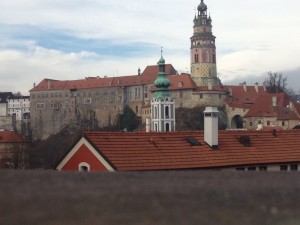Today was our final full day in Europe, and it was very fitting that it was another day packed to the gills with history.
To start off, we visited two different positions on the outskirts of Pointe du Hoc, a French village perched on the sea in the western region of Normandy. Pointe du Hoc overlooks Utah Beach, the second of two invasions sectors manned by the Americans on June 6, 1944.
The first place we saw had huge craters in the ground, at least 20 feet in diameter and seven or eight feet deep from Allied bombing raids leading up to the June invasion. However, only one of the heavy artillery positions was severely damaged, and the rest had to be cleared by the invading soldiers. This was complicated by the fact that each of the bunkers had
The second site was a windswept peninsula overlooking the sea, where the American 2nd Ranger Battalion was instructed to knock out the powerful German cannons stationed there. On D-Day, the commander, Lt. Colonel James Rudder was told to tell the naval protection the first part of the mission was successful once his entire unit had scale the hundred-foot high cliffs. If Rudder did not call by 7:30 am, that would mean he was facing stiff resistance, and the accompanying ships would start bombarding the German fortifications. The Rangers came under withering fire by the German defenses, and the last man only reached the top of the cliffs a few minutes after 7:30 am, so the American soldiers then had to contend with heavy naval shelling along with enemy fire. After an intense battle, the Rangers captured the bunkers, often by sending in flamethrowers to charr the snipers who hid in deep inside the multi-room bunkers. The mission was complicated by the fact that each bunker had escape tunnels to deal with, and the Americans ran low on ammunition by midday. They asked for more ammunition, but their supply boat sank on a sea mine. Thus they resorted to using German weapons taken from dead German soldiers, but then when American reinforcements came two days later, the reinforcements heard the signature sound of German weaponry and fired on the Rangers before realizing they were American. Only 40% of the Rangers survived the two days.
Later we walked down on Utah Beach, on the site where former president Theodore Roosevelt’s son, Theodore Roosevelt Jr., commanded the invasion force. The landing crafts carrying his soldiers were pushed off course by the unusually strong ocean currents in the immediate area, and they landed about a mile south of the intended landing sector but this was a stroke of very good luck. The intended sector was chosen for having four outlet roads to the Normandy countryside, but it was in turn guarded by 20 German bunkers; the actual landing sector only had one outlet road but was guarded by only five bunkers, which did not put up much resistance. The result was that Utah Beach suffered only 12 casualties during the landing, easily the least number of casualties between the five beaches. Unfortunately, over 150 soldiers, weighed down by packs exceeding 70 lbs., drowned in the surrounding artificial swamps created by German war mastermind Erwin Rommel; it is ironic that far more men were killed by the swamps than by the German defenses.
Lastly, we visited the town of Sainte-Mere-Eglise where American paratroopers were dropped around 1:40 am, June 6, to secure the town and its strategic road to the Utah and Omaha Beaches. Allied bombing had just set fire to one of the town’s houses when the paratroopers were descending, illuminating them against the black night and making them easy targets for the German soldiers defending the town. Those who survived long enough to land met surprisingly little resistance that night while capturing the town but had to withstand determined German counterattacks once daylight arrived before being reinforced by tanks the next day, June 7.
And with that our delightful history trip comes to a close. It’s been an wonderful month, each day filled with novel adventure. From proud Germany to playful Czech Republic, then back to Germany and on to picturesque France, this trip has been the most amazing experience of my life – one I will never ever forget.

 Follow
Follow







